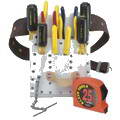» Home
» Electrical Wiring Directory
» Electrical Wiring Tools
» Need Electrical Help? Ask the Electrician
» Need Electrical Help? Ask the Electrician
Electrical Hand Tools
Electricians Tools for Electrical Work

|
By Dave Rongey
Summary: Here are the actual hand tools I use on most all of my electrical jobs and projects. © By: Dave Rongey |
Electrician's Hand Tools
Electrical hand tools are essential for an electrician
Be sure you are using a good quality set of tools.
The job will go much smoother and you will not fatigue as easily due to the stress of not having the right tools for the job.
| A good tool pouch is necessary to have your tools at your side right when you need them. The pouches on the opposite side will have the items necessary for the phase of work that I am doing. During the rough-in phase of wiring a home I have at least two sizes of romex staples and screws for mounting junction boxes. During the make-up phase I will have three different sizes of wire connectors, usually yellow, red and blue. |
|
| You don't want to overload your pouch with tools otherwise you will get fatigued and it can get uncomfortable. Here is the basic list of tools I use: Long nose hammer, Pliers: Lineman's, crimp and needle nose. Screw Drivers: Large and medium straight slot, offset, and phillips and awl or pick . Wire Strippers, box cutter razor blade. Carpenters Pencil, Crayon and Black felt pen. Electrical Tape: Black, White, Red and Green |
|
|||||||
| Electrical Wiring Tools Questions and Answers |
The Safest Way to Test Electrical Devices and Identify Electric Wires!The Non-Contact Electrical TesterThis is a testing tool that I have had in my personal electrical tool pouch for years, and is the first test tool I grab to help identify electrical wiring. It is a Non-contact tester that I use to easily Detect Voltage in Cables, Cords, Circuit Breakers, Lighting Fixtures, Switches, Outlets and Wires. Simply insert the end of the tester into an outlet, lamp socket, or hold the end of the tester against the wire you wish to test. Very handy and easy to use.
The Quickest Way to Check for Faulty Electrical Wiring!The Plug-In Outlet TesterThis is the first tool I grab to troubleshoot a problem with outlet circuit wiring. This popular tester is also used by most inspectors to test for power and check the polarity of circuit wiring. It detects probable improper wiring conditions in standard 110-125 VAC outlets Provides 6 probable wiring conditions that are quick and easy to read for ultimate efficiency Lights indicate if wiring is correct and indicator light chart is included Tests standard 3-wire outlets UL Listed Light indicates if wiring is incorrect Very handy and easy to use.
Strip Off Wire Insulation without Nicking and Damaging the Electric Wire!The Wire Stripper and Wire CutterMy absolute favorite wire stripping tool that I have had in my personal electrical tool pouch for years, and this is the tool I use to safely strip electrical wires. This handy tool has multiple uses: The wire gauges are shown on the side of the tool so you know which slot to use for stripping insulation. The end of the tool can be used to grip and bend wire which is handy for attaching wire onto the screw terminals of switches and outlets.. The wire stripper will work on both solid and stranded wire. This tool is Very Handy and Easy to Use. |
||
Residential Electrical Parts and AccessoriesLight Switches 120volt Outlets Circuit Breakers Electrician Tools Voltage Testers |















